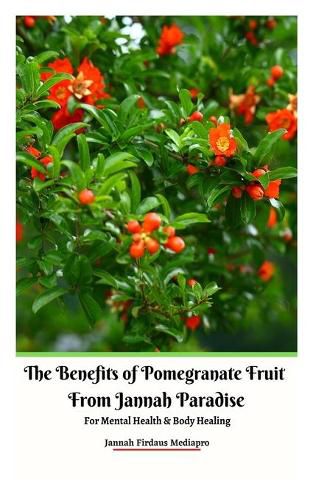Readings Newsletter
Become a Readings Member to make your shopping experience even easier.
Sign in or sign up for free!
You’re not far away from qualifying for FREE standard shipping within Australia
You’ve qualified for FREE standard shipping within Australia
The cart is loading…






This title is printed to order. This book may have been self-published. If so, we cannot guarantee the quality of the content. In the main most books will have gone through the editing process however some may not. We therefore suggest that you be aware of this before ordering this book. If in doubt check either the author or publisher’s details as we are unable to accept any returns unless they are faulty. Please contact us if you have any questions.
The pomegranate is a fruit-bearing deciduous shrub in the family Lythraceae, subfamily Punicoideae that grows between 5 and 10 m tall. The pomegranate was originally described throughout the Mediterranean region.
The fruit is typically in season in the Northern Hemisphere from October to Februaryand in the Southern Hemisphere from March to May. As intact sarcotestas or juice, pomegranates are used in baking, cooking, juice blends, meal garnishes, and smoothies.
Pomegranates are widely cultivated throughout the Middle East and Caucasus region, north and tropical Africa, the Indian subcontinent, Central Asia, the drier parts of Southeast Asia, and the Mediterranean Basin.
Fresh juice doesn’t have to be green or full of spinach to be healthy. Pomegranate juice contains more than 100 phytochemicals. The pomegranate fruit has been used for thousands of years as medicine. Today, pomegranate juice is being studied for its many health benefits. It may help with cancer prevention, immune support, energy boost, antivirus and fertility.
Pomegranates are one of the paradise fruits mentioned in The Holy Quran. Quranic medicine scholars believe that pomegranate as a fruit of paradise comes in autumn because the autumn season is the fall season of trees and clogs of the sky and is very useful in preventing depression and worry.
$9.00 standard shipping within Australia
FREE standard shipping within Australia for orders over $100.00
Express & International shipping calculated at checkout
This title is printed to order. This book may have been self-published. If so, we cannot guarantee the quality of the content. In the main most books will have gone through the editing process however some may not. We therefore suggest that you be aware of this before ordering this book. If in doubt check either the author or publisher’s details as we are unable to accept any returns unless they are faulty. Please contact us if you have any questions.
The pomegranate is a fruit-bearing deciduous shrub in the family Lythraceae, subfamily Punicoideae that grows between 5 and 10 m tall. The pomegranate was originally described throughout the Mediterranean region.
The fruit is typically in season in the Northern Hemisphere from October to Februaryand in the Southern Hemisphere from March to May. As intact sarcotestas or juice, pomegranates are used in baking, cooking, juice blends, meal garnishes, and smoothies.
Pomegranates are widely cultivated throughout the Middle East and Caucasus region, north and tropical Africa, the Indian subcontinent, Central Asia, the drier parts of Southeast Asia, and the Mediterranean Basin.
Fresh juice doesn’t have to be green or full of spinach to be healthy. Pomegranate juice contains more than 100 phytochemicals. The pomegranate fruit has been used for thousands of years as medicine. Today, pomegranate juice is being studied for its many health benefits. It may help with cancer prevention, immune support, energy boost, antivirus and fertility.
Pomegranates are one of the paradise fruits mentioned in The Holy Quran. Quranic medicine scholars believe that pomegranate as a fruit of paradise comes in autumn because the autumn season is the fall season of trees and clogs of the sky and is very useful in preventing depression and worry.